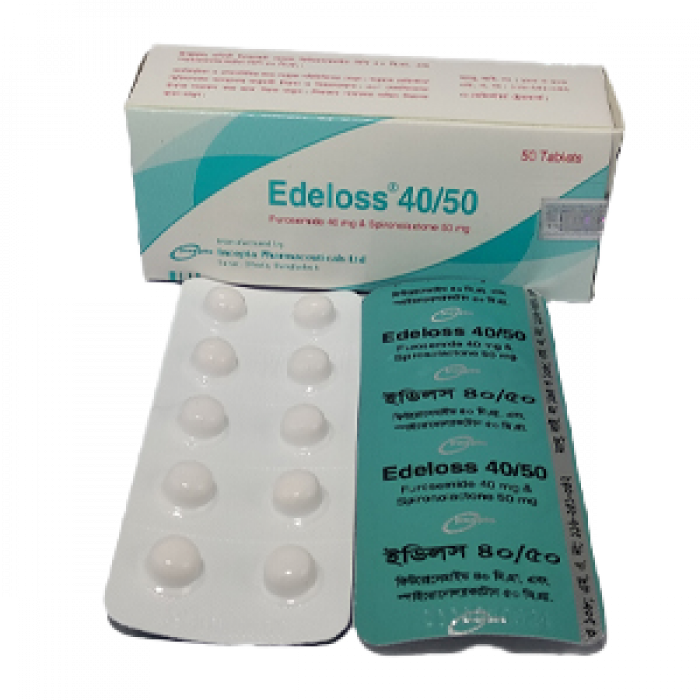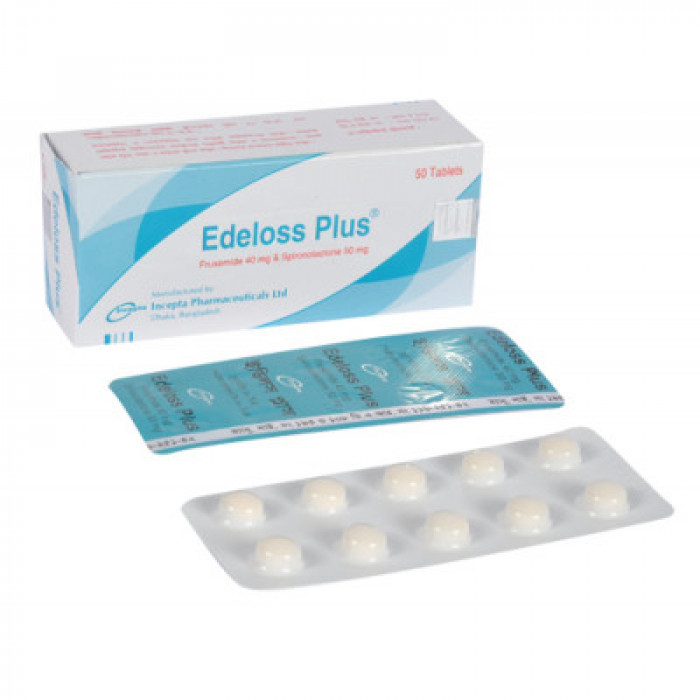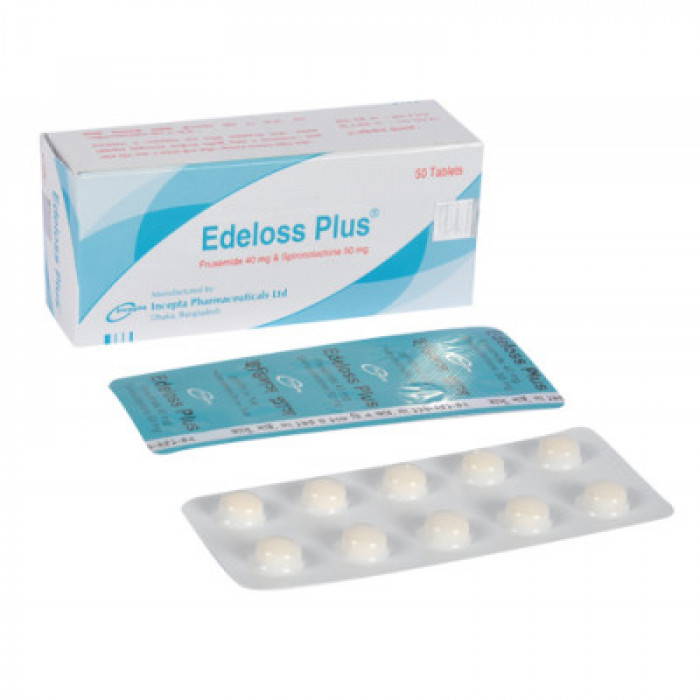
✔ 100% Authentic Product
👁️ Currently Viewing 1852
Edeloss 40/50mg 10pcs
Tablet, Generic Name: Furosemide + Spironolactone 40 mg+50 mg, Manufacturer: Incepta Pharmaceuticals Limited
Discount
Price: ৳ 94
MRP:
৳
100
6%
Off

100% Genuine Products, Guaranteed

Safe & Secure Payments, Always

Fast, Secure & Efficient Delivery

Proper Packaging
 Cash on Delivery - All over Bangladesh
Cash on Delivery - All over Bangladesh Regular Delivery - 12-24 Hours, Dhaka City* Charge Tk.39-59
Regular Delivery - 12-24 Hours, Dhaka City* Charge Tk.39-59 Regular Delivery - 24-48 Hours, Other Cities* Charge Tk.99-110
Regular Delivery - 24-48 Hours, Other Cities* Charge Tk.99-110
 ফ্রি ডেলিভারিঃ - ৯৯৯ টাকা+ অর্ডারে, ঢাকা
শহরে
ফ্রি ডেলিভারিঃ - ৯৯৯ টাকা+ অর্ডারে, ঢাকা
শহরে ফ্রি ডেলিভারিঃ - ২৯৯৯ টাকা+ অর্ডারে, ঢাকার
বাহিরে
ফ্রি ডেলিভারিঃ - ২৯৯৯ টাকা+ অর্ডারে, ঢাকার
বাহিরে
100% Genuine Products, Guaranteed
Safe & Secure Payments, Always
Fast, Secure & Efficient Delivery
Proper Packaging
 Cash on Delivery - All over Bangladesh
Cash on Delivery - All over Bangladesh Regular Delivery - 12-24 Hours, Dhaka City* Charge Tk.39-59
Regular Delivery - 12-24 Hours, Dhaka City* Charge Tk.39-59 Regular Delivery - 24-48 Hours, Other Cities* Charge Tk.99-110
Regular Delivery - 24-48 Hours, Other Cities* Charge Tk.99-110 ফ্রি ডেলিভারিঃ - ৯৯৯ টাকা+ অর্ডারে, ঢাকা
শহরে
ফ্রি ডেলিভারিঃ - ৯৯৯ টাকা+ অর্ডারে, ঢাকা
শহরে ফ্রি ডেলিভারিঃ - ২৯৯৯ টাকা+ অর্ডারে, ঢাকার
বাহিরে
ফ্রি ডেলিভারিঃ - ২৯৯৯ টাকা+ অর্ডারে, ঢাকার
বাহিরে
✅ Description:
Indications
The combination of frusemide and spironolactone is suggested in-
Essential hypertension is a condition in which the blood pressure is
Congestive heart failure (CHF) is a kind of congestive heart failure
Cirrhosis of the liver with fluid accumulation in the abdominal cavity (ascites)
Excess fluid retention causes swelling (edema)
Hyperaldosteronism
Secondary hyperaldosteronism is related with resistant edema.
Pharmacology
Spironolactone (potassium-sparing diuretic) and furosemide (loop diuretic) have different but complementary mechanisms and sites of action. Therefore, when they are administered together, they will produce an additional or synergistic diuretic. The furosemide component inhibits the Na + / K + / 2Cl cotransporter in Henle's ascending circulation and blocks the reabsorption of sodium, potassium and chloride ions; thereby increasing the amount of sodium and water excreted in the urine. This characteristically leads to potassium loss. The spironolactone component inhibits the reabsorption of potassium by sodium in the distal tubules by antagonizing the effect of aldosterone, thereby greatly increasing sodium excretion and reducing excessive potassium loss caused by furosemide.
Dosage & Administration
Furosemide 20 and spironolactone 50 mg: 1 to 4 tablets daily (20 to 80 mg of Furosemide and 50 to 200 mg of spironolactone) according to the patient’s response.
Furosemide 40 and spironolactone 50 mg: For previously stabilized patients requiring a higher dosage of spironolactone and Furosemide, This tablet can be used at a dose of one to two tablets daily (Furosemide 40 to 80 mg and spironolactone 50 to 100 mg).
Use in children: Spironolactone and Furosemide is not suitable for use in children. Spironolactone and Furosemide may both be excreted more slowly in the elderly.
Interaction
There is a higher risk of hyperkalemia when combined with ACE inhibitors or potassium salts. Spironolactone raises the blood levels of cardiac glycosides like digoxin, which can cause digitalis poisoning. When corticosteroids are used with Spironolactone, hypokalemia might occur. When used with indomethacin and potentially other non-steroidal anti-inflammatory medications, Furosemide's blood pressure lowering and diuretic effects may be decreased or eliminated (NSAIDs). Aminoglycoside antibiotics' ototoxicity may be increased by furosemide. Sucralfate and Furosemide given together may decrease the natriuretic and antihypertensive effects of Furosemide.
Contraindications
Spironolactone (a potassium-sparing diuretic) and Furosemide (a loop diuretic) work in distinct ways but compliment each other. As a result, when taken together, they create a diuretic that is additive or synergistic. The Furosemide component inhibits the Na+/K+/2Cl- co-transporter in the ascending Loop of Henle, blocking sodium, potassium, and chloride ion reabsorption and therefore increasing sodium and water excretion in the urine. Potassium depletion is a common side effect of this. By antagonizing the action of aldosterone, the spironolactone component limits sodium reabsorption in exchange for potassium in the distal tubule, resulting in sodium excretion.
Side Effect
Spironolactone can cause headaches, drowsiness, and gastrointestinal discomfort, including cramps and diarrhea. According to reports, ataxia, confusion and skin rash are side effects. Gynecomastia is not uncommon, and in rare cases, breast enlargement persists. Other endocrine disorders include hirsutism, low voice, irregular menstruation, and impotence. There may be a transient increase in blood nitrogen concentration, and there are reports of mild acidosis. Spironolactone can cause hyponatremia and hyperkalemia. Excessive diuresis can lead to dehydration and hypovolaemia with circulatory failure, especially in elderly patients, blood clots and embolism can occur. Consuming too much potassium and magnesium can cause arrhythmia.
Pregnancy & Lactation
Spironolactone and its metabolites may penetrate the placental barrier during pregnancy. When using spironolactone in pregnant women, the expected benefit must be balanced against the potential risks to the mother and fetus. Furosemide may induce prenatal malformations, according to animal teratology studies. As a result, furosemide should only be used in women of childbearing age if adequate contraception is utilized or if the possible benefits outweigh the hazards to the fetus.
Lactation: Spironolactone metabolites have been found in breast milk. If the usage of Spironolactone is deemed necessary, an alternative baby feeding technique should be used. Furosemide is excreted in breast milk, therefore if you need to take it, you should stop breastfeeding.
Precautions & Warnings
In patients who are at risk of electrolyte deficit, caution is advised. In diabetes, enlarged prostate, hypotension, and hypovolemia, this medication should be taken with caution.
Therapeutic Class
Potassium-sparing diuretics, Potassium-sparing diuretics & Aldosterone antagonists
Storage Conditions
Keep below 30°C temperature, away from light & moisture. Keep out of the reach of children.
⚠️Disclaimer:
At ePharma, we’re committed to providing accurate and accessible health information. However, all content is intended for informational purposes only and should not replace medical advice from a qualified physician. Please consult your healthcare provider for personalized guidance. We aim to support, not substitute, the doctor-patient relationship.









